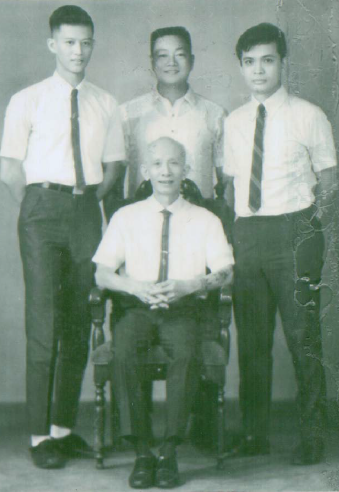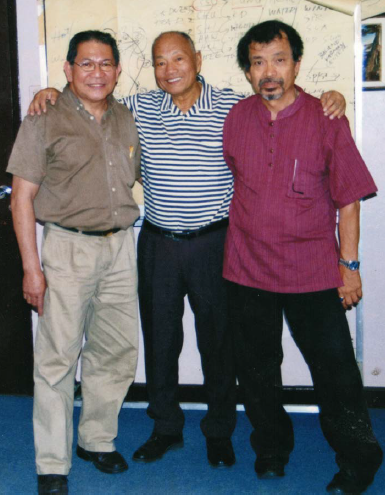When I began studying Shaolin Kungfu with Johnny F. Chiuten, I was told by him that the style was Hung Ga or Angka or Hong Cha, depending on the dialect. This was in the mid-1960s when we did not have the internet and there was really a paucity of information about martial arts. Then when I settled in the US I learned in the 1970s that there were several styles of Hung Gar, each claiming authenticity and bragging rights, with different forms and techniques that “evolved” from the original ancestor in the Southern Shaolin in Fujian back during the Qing Dynasty.
But when I researched the “history” of the system, I found no continuity or credibility in the narrative of this ancestral monk, considered the original founder, and his curriculum of forms and teachings. There was indeed no evidence at all of what he studied or transmitted to his students or the chain of disciples that studied the system. Hung has been described as “legendary” – meaning nothing much was known about him or his teachings. His existence and life were just myth and legend that grew through the years, embroidered by books and movies until he grew into a larger- than- life character. I mean no disrespect for this wonderful art or the venerable name but sadly, hardly anybody has questioned this lineage. Like the Buddhist patriarch Bodhidharma and Zhang San Feng of Tai chi chuan fame, Hung is emblematic of those sacrosanct icons and narratives perpetuated by silence or repetition and exaggeration.

It was somehow the same and different with Lao Kim. He called his martial arts style Hung Gar/Hong Cha/Angka and traced his ancestry to a Shaolin temple in Fujian. When Mark V. Wiley and I researched the Lao Kim Style, we realized that there was really a Buddhist temple in Fujian province but it was burned because it was the refuge of anti-Manchu rebels – where it was located cannot be determined; there are at least 3 or 4 such temples that claim to be located in the same place as the original. From the story, the only reliable and established fact is that Lao Kim studied in a Buddhist temple in Fujian. Was it the “legendary” Southern Temple in the Fujian mountains? We’ll never know for sure. Mark’s research found that there were martial arts schools in Fujian that were called “Plum Blossom,” “Dragon Tiger” and “Red Boy Praying to Kuanyin,” the most prominent forms in Lao Kim’s transmissions. So Mark and I decided to call the style “Dragon Tiger Fujian Temple Kungfu,” not Hung Gar or Shaolin. Dragon Tiger because that is the most advanced and prominent form in his system, Fujian Temple because that is where it came from, and Kungfu because that is the word that is almost synonymous with Chinese external martial arts. We could not go any farther in the “lineage” – the ancestry went back to Lao Kim and began with him. We had no alternative but stick to the verifiable facts. So Lao Kim was the first ancestor of this style whose provenance we do not know. But we did not attribute it to the mythical ancestor Hung whose existence and teachings we do not know anything about.
The videos of old Lao Kim doing a masterful Kang Li Kuen and young Ching See San doing an athletic Dragon Tiger Kuen are from the curriculum of the Dragon Tiger Fujian Temple Kungfu. Kang Li Kuen is a basic form in the system while Dragon Tiger is the most advanced form. Johnny Chiuten said that Lao Kim trained in a Buddhist temple in Fujian Province when he was a young boy. The story goes that the relatives of Lao Kim were massacred by the soldiers of the Qing army possibly because they were suspected of being rebels against the Manchu dynasty. Lao Kim was spared because he hid in a latrine. When he came out, he walked among the dead bodies of his family. Two Buddhist monks were begging in the village when they saw the orphan crying; they brought him to the abbott in the temple on top of the mountain. Lao Kim was adopted and since then, for 10 years, trained as a Buddhist monk with the others. He also studied a martial arts called Hong-Cha, Angka or Hung Gar, one of the styles based on the 5 Animals (Dragon, Tiger, Snake, Leopard, and Crane). Mark V. Wiley, martial arts master and scholar, and I researched the history of the system and realized that there is no reliable documentation of the life, training and curriculum of the legendary founder Hung, Hong or Ang (Hei Gun) or his alleged teacher and fellow monk and refugee from the Northern Shaolin Temple in Loyang, Hunan, Jee Sin Sim See. The possibility and the more credible narrative is that some Hung family systems evolved out of a more recent master, Wong Fei-Hong and his father. So we decided to call Lao Kim’s system Dragon Tiger Fujian Temple Kungfu: Dragon Tiger because that is the most advanced form, Fujian Temple because that’s where Lao Kim studied, and Kungfu because the word is almost synonymous with Buddhist Shaolin martial arts. We have no information about Lao Kim’s immediate teacher, so Lao Kim was the first ancestor in the lineage.
Lao shifu moved to Hongkong when he was offered a job as a martial arts film director. I saw him at his small one-bedroom flat on Kowloon a few times. On one occasion he gifted me with a 36-herbal formula written in his own hand; on my last visit, in 1995, it was an album containing rare photographs of himself. He passed away at the millennium when he was 114 years old. His story is told in my book “Of Fire and Water: Alchemy and Transformation (Tambuli Media: 2022) available on Amazon.
Except for the preliminary form that Johnny F. Chiuten called “Pre-Kata,” i.e., it was often the very first moving form that was taught after the basic stationary stances, all of Lao Kim’s forms (fist and weapons) had a salutation that started with the audience on the left side and ended with the audience in front, after which the actual form started. The Dragon Tiger form is not only the most advanced, it is likewise the longest and most complicated. Movements are often done in a series, nothing is repeated and each movement is done in a different direction. I studied Dragon Tiger with Johnny and Lao Kim.

> Johnny flew in from Cebu, Jopet Laraya from Canada and Rene from the United States. They stayed at the hotel for a week and reviewed materials from the curriculum.
How the videos of Lao Kim’s forms came to my possession is a story in itself. Johnny had shot the forms on a Super 8 camera back in the late 1970s or early 1980s.He wanted to give them to me when he was in Canada and I was in the US. A friend borrowed them from Johnny and did not return them. It was not known what happened to this friend. But 10-15 years later I was given a VHS film by a martial artist when I was in the Philippines. It was obviously the same film that Johnny was planning to give to me. As far as I know, the original Super8 film was never returned to Johnny. I know a couple of similar stories about people borrowing films or videos and not returning them. Moral of the story: If you think they are valuable and are meant to be private, do not lend your videos, keep them in your safe!
The forms of Lao Kim included:
Fist Forms:
#10 Form (often called Cross Form because #10 is a cross)*/1
Plum Blossom*
Dragon Tiger*/2
Kang Li/3
Dragon Tiger White Crane/4
Offering/5
Wat Let
Red Boy Praying to the Goddess of Mercy*/6
Fist Attack
Weapons:
Staff (3 forms)
Spear
Broadsword
Sword
Hoe
Guandao
5-Sectional Steel Whip
Lao had other fist and weapons forms but the list above is what I studied.
*I also studied these forms with Johnny F. Chiuten before I studied them with Lao Kim.
/1,2,3, 4, 5 and 6 are included in the videos. Credit is owed to Manny Maramara for his technical work on the videos. We will feature more of Lao Kim’s forms in later.